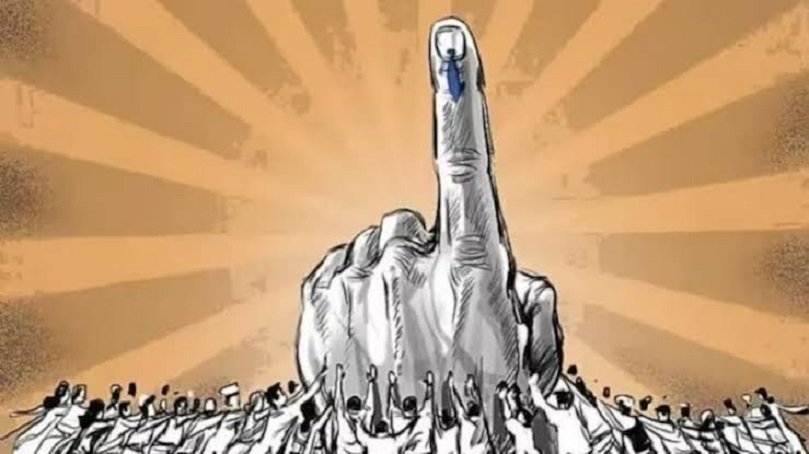Tuesday’s Twin Tests: Bypolls to Gauge J&K’s Power Pulse
By: Javid Amin | 06 November 2025
Budgam and Nagrota brace for symbolic political battles in post-Article 370 Jammu & Kashmir
Overview: Twin Bypolls, One Message
The political temperature in Jammu and Kashmir is rising sharply as the region braces for two crucial by-elections on November 11, 2025—in Budgam and Nagrota. Far from being mere mid-term contests, these elections are shaping up as referendums on power, identity, and governance in a territory still finding its democratic rhythm after the abrogation of Article 370.
For many observers, these bypolls are mini-general elections in disguise—offering a real-time snapshot of voter mood, party credibility, and the durability of alliances between regional and national forces.
From the Shia-dominated lanes of Budgam to the nationalist heartland of Nagrota, political loyalties are being tested, legacies are at stake, and every vote carries symbolic weight in the evolving political order of Jammu & Kashmir.
Twin Bypolls: What’s at Stake
Budgam – “Aga vs Aga vs Aga”: A Family, A Faith, A Fight
Budgam’s by-election is arguably the most dramatic political showdown in recent Kashmiri history. It’s not merely a contest between parties—it’s a clash within one of the Valley’s most influential religious families, the Aga family.
Three members of the same lineage are contesting under three different banners:
-
Aga Syed Mehmood (National Conference – NC)
Backed by the ruling coalition, Mehmood is banking on his development track record and traditional Shia support base in Budgam. His campaign emphasizes continuity, welfare programs, and secular inclusivity—a hallmark of the NC’s political brand. -
Aga Syed Ruhullah (People’s Democratic Party – PDP)
Known for his fiery ideological clarity and vocal criticism of the post-Article 370 political arrangement, Ruhullah represents the resistance narrative. Though not aggressively campaigning, his mere name commands deep emotional resonance among Kashmiri voters seeking ideological authenticity. -
BJP’s Aga Candidate (name withheld until nomination confirmation)
The saffron party’s strategy is bold: field a Shia cleric from within the Aga lineage to counter the NC-PDP axis and break religious vote monopolies. The BJP’s narrative is built around development, nationalism, and empowerment—seeking to tap into sections disillusioned with traditional Valley politics.
This “Aga vs Aga vs Aga” triangle has turned Budgam into a theater of legacy and identity, raising fundamental questions:
Will faith override ideology? Or will political convictions fracture religious unity?
Nagrota – BJP’s Legacy on the Line
Down south in Nagrota, the BJP faces a test of endurance. Having secured victory here in 2024, the party now confronts anti-incumbency, infrastructure gaps, and a growing opposition front that sees an opportunity to puncture its stronghold in the Jammu belt.
Nagrota holds immense symbolic value for the BJP—it represents the core of its Jammu support, often cited as evidence of the party’s emotional and political connect with nationalist voters. But as local frustrations mount over poor road connectivity, erratic power supply, and employment stagnation, cracks are emerging in that once-solid base.
-
BJP’s Devyani Rana (daughter of late MLA Devender Singh Rana) is leading the campaign. She carries both the burden of legacy and the challenge of expectation, after the sudden demise of her father—an influential figure in Jammu politics.
-
The National Conference (NC) and Congress are subtly coordinating to prevent vote fragmentation, eyeing the consolidation of anti-BJP sentiment.
-
The Aam Aadmi Party (AAP), though not a major force in J&K, is attempting to inject an alternative governance narrative, appealing to urban and youth voters frustrated with both traditional camps.
The Nagrota bypoll, thus, is more than a seat—it’s a litmus test for the BJP’s post-2024 resilience, and an indicator of whether its Jammu narrative still resonates amid governance fatigue.
Broader Political Pulse: More Than Just Two Seats
These twin contests are being widely read as mini-referendums on Jammu & Kashmir’s evolving political architecture. With statehood still unresolved, governance shared between the elected cabinet and the Lieutenant Governor’s office, and economic discontent simmering, voters are being pulled by both emotions and pragmatism.
The National Conference (NC), under Omar Abdullah, seeks to consolidate its image as the voice of autonomy and stability, especially after sweeping three out of four Rajya Sabha seats earlier this year. The BJP, meanwhile, is eager to demonstrate that its nationalist model continues to deliver despite administrative friction.
For the PDP, the bypolls are about relevance—testing whether its ideological commitment to “self-respect and dialogue” still resonates after years of political marginalization.
These bypolls also reflect a rebalancing of identity politics in a region long divided between faith-based affiliations, regional aspirations, and nationalist narratives.
Key Themes and Underlying Currents
The Ghost of Article 370
Nearly six years after the constitutional revocation, Article 370 continues to shadow every political campaign in J&K.
While the BJP presents it as a historic correction and a gateway to integration, regional parties frame it as a loss of identity and rights.
The bypolls serve as the first localized test of how deeply this polarization endures in the voter psyche.
Sectarian Undercurrents in Budgam
The Budgam contest has stirred sectarian introspection within the Shia community.
For decades, the Aga family symbolized unity and guidance. But as political allegiances splinter, many fear the commercialization of faith and identity.
Yet, for younger Shia voters, this election offers a rare chance to redefine representation, separating religious reverence from political allegiance.
Jammu’s Urban Pressure Points
In Nagrota, developmental fatigue is palpable. Local grievances include poor infrastructure, youth unemployment, and water shortages—issues that cut across party lines.
For many residents, this bypoll is not about ideology but accountability—a verdict on whether promises of “Naya Jammu” have translated into daily improvements.
The Alliance Equation
Post-Rajya Sabha elections, cracks have appeared in the NC-Congress understanding, with both sides cautious about mutual dependence.
While public statements project cooperation, private negotiations and constituency-level rivalries tell a different story.
If Congress decides to boycott or underplay its role in the bypolls—as it did in recent cabinet discussions—it could reshape coalition arithmetic ahead of the next assembly election.
Public Sentiment: The Real Referendum
On the ground, the mood is mixed. Many voters express skepticism toward “photo-op politics”—frequent rallies, promises of reform, and superficial development projects.
For them, the bypolls are a test of trust, not just party strength. The issues dominating conversations include:
-
Unemployment: Still one of J&K’s most pressing challenges, with educated youth feeling alienated from both government and private job avenues.
-
Reservation and Representation: New delimitation policies and reservation rules have left several communities—especially Gujjars, Paharis, and minorities—questioning their future representation.
-
Dual Governance Friction: The overlapping roles of the elected Chief Minister and the Lieutenant Governor often lead to administrative delays, confusing accountability and slowing reform.
Election Optics: A Battle of Narratives
Each party has carefully crafted its messaging to resonate with its core audience:
-
BJP: “Development, Dignity, and Integration” – projecting stability and nationalism.
-
NC: “Autonomy and Identity” – invoking emotional loyalty and historical legitimacy.
-
PDP: “Dialogue and Dignity” – emphasizing ideological steadfastness.
-
Congress: “Restoration and Representation” – focusing on democratic completeness and equality.
In many ways, these narratives mirror India’s broader political fault lines—centralization vs autonomy, nationalism vs regional identity, and ideology vs practicality.
What Comes Next
As campaigning intensifies, political observers predict record voter turnout driven by high emotional stakes and localized grievances.
-
If NC sweeps both seats, it will solidify its dominance and moral edge in the upcoming assembly elections.
-
If BJP retains Nagrota and makes inroads in Budgam, it will claim proof of acceptance of its governance model in both regions.
-
If PDP or smaller players perform unexpectedly, the fragmentation of opposition could reset alliance negotiations for 2026.
Beyond numbers, these bypolls will reshape the language of politics in Jammu and Kashmir—determining whether the region moves toward reconciliation or deeper polarization.
Conclusion: More Than Votes—A Test of Vision
Tuesday’s twin bypolls in Budgam and Nagrota are about more than seats—they’re about identity, governance, and belonging in a region caught between its past and future.
They will reveal whether family legacy still commands loyalty, whether nationalism can outlast local fatigue, and whether J&K’s democracy can truly represent its diversity.
In essence, these elections are not just a test for parties—they’re a mirror of public faith, reflecting how far Jammu & Kashmir has come in its journey toward political normalcy, and how far it still has to go.




